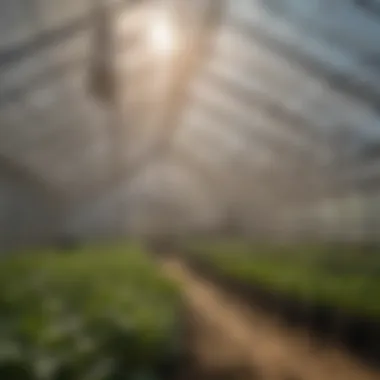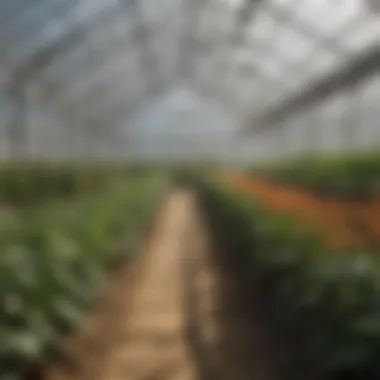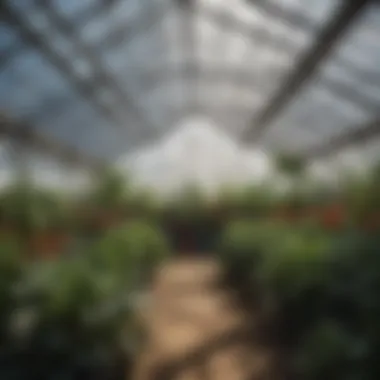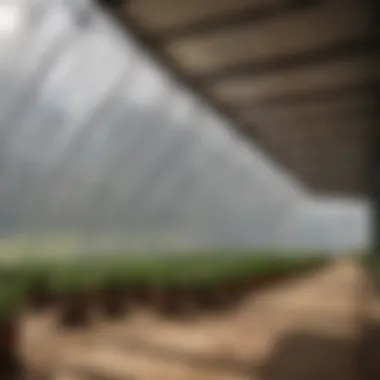Understanding Greenhouse Shade Tarps: Applications and Benefits


Intro
In the world of horticulture, greenhouse shade tarps play a pivotal role in optimizing plant growth and health. Understanding their significance is essential for both professional and amateur gardeners. These tarps help manage light exposure and temperature, crucial factors in successful plant cultivation. Moreover, they offer an economical solution to many challenges faced while growing plants in various climates.
The application of shade tarps extends beyond just light control; they are integral for enhancing the overall health of plants by regulating environmental conditions. With a variety of materials available, choosing the right tarp can profoundly affect the growth outcomes for different plant species.
Key Insights
Overview of the Topic
Greenhouse shade tarps come in different types and materials, each designed for specific applications. Common materials include polyethylene and polypropylene, which provide varying degrees of shade and UV protection. Understanding the characteristics of these materials enables growers to select the most suitable option for their plants’ needs.
Shade tarps can also support air circulation within a greenhouse. Proper installation and positioning play a key role in harnessing the full potential of these products. This entails learning how to balance shade and natural light, which is vital for photosynthesis.
Importance in Agriculture/Horticulture/Agronomy
The significance of shade tarps cannot be understated. In agriculture, they reduce the risk of sunburn on fruits and leaves, thereby improving crop yields. In horticulture, they assist in establishing a controlled environment, leading to healthier plants that mature properly.
The benefits extend to increased water efficiency, as shade tarps can reduce evaporation rates. Furthermore, they help mitigate heat stress during hot summer months, ensuring plants remain resilient. Proper utilization of shade tarps contributes to natural resource conservation, aligning with sustainable agricultural practices.
"Greenhouse shade tarps are not merely protective covers; they are essential tools in the quest for optimal plant growth."
Sustainable Practices
Eco-Friendly Techniques
Using shade tarps aligns with eco-friendly horticultural techniques. By emitting less heat and minimizing water loss, growers can foster more sustainable agricultural practices. Also, utilizing tarps made from recycled materials can further enhance the eco-friendliness of the gardening approach.
Case Studies on Sustainability
Studies have shown that regions utilizing shade tarps experience a marked increase in crop yields when compared to those that do not. For instance, farmers in arid zones have reported a 30% rise in production after implementing shade tarps. These findings underscore the importance of integrating shade management into agricultural planning.
Tools & Resources
Essential Equipment and Technologies
To effectively use shade tarps, several tools are essential. These include
a. tarp fastening systems,
b. adjustable support structures, and
c. weather-resistant materials.
Understanding these equipment types ensures the longevity and effectiveness of the tarps in varied environmental conditions.
Recommended Books and Readings
For further insights into horticulture and sustainable practices, consider reading the following:
- "The Greenhouse Gardener's Manual" by Roger Marshall
- "Gardening Under Lights" by Leslie F. Halleck
Expanding your knowledge in these areas will enrich your gardening experience and enhance your understanding of effective tarp usage in greenhouses.
Preamble to Greenhouse Shade Tarps
Greenhouse shade tarps play a critical role in modern horticulture. They serve various functions, from regulating temperature to controlling light exposure. Understanding how these tarps contribute to plant health is essential for both professional and hobbyist gardeners. Their applications extend beyond simple shading; they help create optimal conditions for plant growth, maximizing productivity and ensuring better yields.
Definition and Purpose
Greenhouse shade tarps are specialized covers designed to reduce sunlight intensity and heat within a greenhouse. These tarps come in various materials and shade percentages, aptly catering to different plant needs and environmental conditions. By limiting direct sunlight, they help manage the internal climate, keeping plants healthy and productive.
The primary purpose of these tarps is to minimize the harmful effects of excessive sunlight and heat. For most plants, too much light can lead to stress and damage. Thus, using shade tarps appropriately protects plants, enhancing their overall performance. Proper shade levels contribute to improved water retention in the soil and reduced moisture loss, which translates into healthier plants and less frequent irrigation required.
Historical Context


The use of shade tarps in agriculture is not a new concept. Historical records indicate that gardeners and farmers have used various methods for shading plants for centuries. Ancient civilizations employed natural materials, such as woven palm fronds or cloth, to protect crops from harsh sunlight. Over time, advancements in materials and technology have led to the development of specialized shade products.
In the late 20th century, as commercial greenhouse farming started to grow, the need for effective shading solutions became increasingly apparent. This shift prompted manufacturers to produce durable, lightweight, and UV-resistant materials specifically designed for greenhouses. Today, variety ranges from basic shade cloths to more sophisticated tarps that also provide insect protection, durability, and enhanced insulation.
The evolution of greenhouse shade tarps reflects a deeper understanding of plant biology and horticultural practices. They now represent a fundamental aspect of modern gardening strategies, enabling growers to adapt to changing climate conditions and ensure optimal growth for various crops.
Types of Greenhouse Shade Tarps
The selection of shade tarps is an essential factor in optimizing the conditions within a greenhouse. Different types of greenhouse shade tarps can significantly influence the growth performance of plants. Understanding these various types helps growers make informed decisions tailored to their specific horticultural needs and environmental considerations.
Material Composition
Polyester
Polyester tarps are a common choice in greenhouse settings. Their durability is unmatched, making them long-lasting under various weather conditions. One key characteristic of polyester is its resistance to UV rays, which ensures that the tarp maintains its structural integrity over time. Also, they are relatively lightweight, which simplifies installation and removal. However, polyester tarps can sometimes be more expensive than alternatives like polyethylene. Their unique feature is the balance between weight and strength, which makes them effective for both commercial and home gardening applications.
Polyethylene
Polyethylene is another popular option for greenhouse shade tarps. This material is known for its affordability and effectiveness. One key characteristic is its versatility; it can be found in a range of thicknesses. Thicker polyethylene tarps provide enhanced durability through adverse weather. However, thinner options are available to allow for more light penetration. A unique advantage of polyethylene is its moisture resistance, which reduces the risk of mold or algae growth. Its main disadvantage can be the potential of degradation over time when exposed to continuous UV radiation.
Shade Cloth
Shade cloth tarps offer a different approach to shading in greenhouses. This material is woven, allowing for breathable coverage. A significant characteristic of shade cloth is its ability to provide varying degrees of shade, making it highly customizable. Growers can select shades based on specific plant requirements. Its unique feature lies in its flexibility to adapt to different crops, making it a popular choice among both commercial growers and home gardening enthusiasts. However, shade cloth may not provide the same level of durability as polyester or polyethylene, and this could lead to concerns over longevity.
Shade Percentages
The percentage of shade provided by tarps is crucial for plant health. Selecting the right shade percentage impacts temperature regulation, growth rates, and overall plant vitality.
Light Shade
Light shade tarps generally provide around 30-50% shade. This is particularly valuable for sensitive plants that thrive under diffused light conditions. One main characteristic of light shade tarps is their ability to filter sunlight effectively while still allowing ample light to penetrate. They are beneficial for germinating seeds and nurturing young plants. The unique feature of light shade lies in its gentle touch on delicate crops while protecting against direct sunlight, ensuring proper growth without causing stress.
Medium Shade
Medium shade tarps provide a balance, often shading about 50-70% of direct sunlight. This shade type is optimal for many plants that require some sunlight but can also be sensitive to overheating. A key characteristic of medium shade tarps is their adaptability across various plant types. They protect from intense sunlight while still supporting photosynthesis. However, there is a downside; excessive use of medium shade can inhibit growth for some plants that require higher light levels.
Heavy Shade
Heavy shade tarps offer the highest level of protection, usually blocking 70% or more sunlight. This is especially relevant in environments where the sun is harsh or in regions with high temperatures. A significant characteristic of heavy shade tarps is their ability to create cooler microclimates. They protect plants from the detrimental effects of too much heat and light. However, the main drawback is that not all plants will thrive under such conditions, as some may require more sunlight to grow effectively. Thus, careful consideration must be taken when using heavy shade tarps to avoid stunted growth.
Benefits of Using Shade Tarps
Using greenhouse shade tarps brings several advantages to both commercial and home gardening. These coverings not only help in managing environmental conditions but also significantly enhance the wellbeing of plants. Understanding the myriad benefits allows gardeners to make informed choices for the health of their crops.
Temperature Regulation
Temperature plays a crucial role in plant growth. Excessive heat can lead to stress, affecting growth rates and overall health. Shade tarps effectively moderate temperatures within the greenhouse. During scorching days, these tarps block harmful UV rays, lowering the inside temperature, which can be critical for sensitive plants.
Shade tarps are available in various grades that reflect different percentages of light. Choosing a tarp that provides the correct shade percentage will assist in keeping temperatures manageable. For instance, heavier shade tarps can significantly reduce heat during peak sunlight hours.
Light Control
Not all plants thrive under the same light conditions. Some need direct sunlight to flourish, while others require filtered light to avoid damage. Greenhouse shade tarps help create optimal light environments by controlling intensity.
By selecting tarps with the right shade percentage, you can customize light exposure for different plants. This control can aid in healthy growth and prevent issues such as leaf burn and poor fruit set. Additionally, the right amount of light is essential for photosynthesis, which is vital for a plant’s energy.
Enhanced Plant Health
The use of shade tarps enhances plant health in several ways. Firstly, by managing temperature and light exposure, they help reduce stress on plants. Healthy plants are less susceptible to diseases and pest infestations. Furthermore, shade tarps can protect plants from wind and heavy rain, providing a more stable environment for growth.
"Effective use of shade tarps supports a balanced microclimate suitable for various plant species, promoting resilience against environmental stressors."
By creating a more controlled environment, gardeners can expect improved yields and possibly quicker growth cycles. This results in higher efficiency in both time and resources invested in gardening, making shade tarps a wise choice for sustainable horticultural practices.
Installation Techniques


Installation techniques play a critical role in maximizing the efficiency and effectiveness of greenhouse shade tarps. Proper installation ensures that the shade tarps can perform their intended functions, such as temperature regulation and light control, in the best possible way. The right techniques can enhance the durability of the tarps, reduce wear and tear, and ultimately save time and money in gardening practices.
Selecting the Right Location
Choosing the right location for shade tarp installation is essential. This involves considering sun exposure, wind patterns, and temperature. Placement can dramatically alter how well plants grow beneath the tarp. For example, areas with direct sunlight may require heavier shade tarps to protect sensitive crops from overheating. In contrast, regions with high winds may call for additional anchoring methods to prevent damage. By analyzing these factors, one can ensure that the tarps provide optimal conditions for plant growth.
Attachment Methods
Attachment methods are equally important as they provide the structural integrity needed for shade tarps to remain securely in place.
Clip Systems
Clip systems are a popular choice for attaching shade tarps due to their ease of use and reliability. These systems allow for quick attachment and detachment of the tarp, making them ideal for seasonal installations. The main advantage of clip systems is their flexibility; growers can adjust the tarp's position as needed, depending on weather conditions. However, the challenge with clip systems is that they may not hold up as well in extreme weather, such as heavy storms.
Grommets
Grommets provide a sturdy option for securing shade tarps. These reinforced holes in the tarp allow for ropes or hooks to pass through, ensuring a tight and secure fit. Grommets are beneficial for their strength and durability, making them suitable for both temporary and permanent applications. One unique feature is their ability to withstand significant tension without tearing. On the downside, the installation process can be somewhat labor-intensive as proper alignment is needed to ensure effectiveness.
Rope
Using rope is one of the oldest methods for securing shade tarps. This method involves tying the tarp down to fixed points or structures around the greenhouse. One key characteristic of rope attachment is its adaptability; growers can use various knots to achieve the desired tension. This method is practical for those who prefer a low-cost solution. However, the disadvantage is that it requires more attention to ensure that the ropes remain tight over time, as they can loosen due to weather changes.
Proper installation and attachment methods significantly enhance the functionality of greenhouse shade tarps, ensuring that your horticultural practices yield the best possible results.
Maintenance of Shade Tarps
Proper maintenance of shade tarps is a crucial aspect for anyone engaged in horticulture. Without consistent care, these tarps can lose their effectiveness, leading to detrimental effects on plant life. Regular maintenance helps to ensure that the shade tarps provide the intended benefits in terms of temperature regulation, light control, and overall plant health.
By adopting effective cleaning routines and addressing any issues of wear and tear promptly, gardeners can significantly prolong the lifespan of their shade tarps while optimizing their performance. As one understands the nuances of maintenance, it becomes clearer how these practices contribute to sustainable horticultural practices.
Cleaning Routines
Cleaning routines for shade tarps can vary based on the materials used and the climate in which they are deployed. For instance, polyethylene tarps may require different cleaning methods compared to polyester products. Regular cleaning removes accumulated dirt, algae, and other debris that can inhibit the tarp's ability to filter light and manage temperatures effectively.
- Frequency: It is recommended to clean the tarps at least twice a year—once before the growing season and once after.
- Methods: A gentle detergent mixed with water can be effective. Use a soft brush to avoid damaging the material.
- Drying: Always ensure the tarp is completely dry before folding or storing it to prevent mildew.
Taking these steps not only maintains the structure of the tarp but also ensures it functions optimally throughout its use.
Repair and Replacement
Though shade tarps are designed for durability, they can still suffer from tears or fading due to environmental stressors. Immediate attention to minor repairs can extend the life of the tarp and prevent the need for complete replacement.
- Inspection: Regularly inspect your tarps for signs of damage such as frayed edges or small holes. Early detection allows for easier repairs.
- Repair Methods: For small tears, specialized tape or patches designed for tarp materials can provide a quick fix. For more significant damage, sewing the fabric may be necessary, and sometimes consulting a professional may be prudent.
- Replacement Considerations: Assess whether a tarp’s effectiveness has diminished. If it has lost its protective qualities or shows significant degradation, consider planning for replacement. Frequent replacement can lead to higher costs, so weighing the benefits of a repair versus a replacement is essential.
"A well-maintained shade tarp is an investment in the health and productivity of your plants. Regular cleaning and prompt repairs make a significant difference."
In summary, maintaining shade tarps through proper cleaning routines and timely repairs can greatly enhance their longevity and functionality. These practices not only contribute to the resilience of the tarps but also support the overarching goals of successful horticulture.
Economic Considerations
The use of greenhouse shade tarps involves several economic factors that growers must consider. Implementing these tarps can offer significant advantages that impact both initial investments and ongoing operational costs. Understanding these elements helps inform decisions that maximize return on investment and improve overall productivity in horticultural endeavors.
Cost-Benefit Analysis
A detailed cost-benefit analysis is essential when evaluating the use of greenhouse shade tarps. Initially, costs may include purchasing the shade tarp itself, installation fees, and maintenance expenses over time. Yet, these upfront financial considerations must be weighed against the numerous benefits provided.
The benefits often manifest in several ways:
- Increased Crop Yield: Shade tarps can help prevent crop damage due to excessive sun exposure, leading to healthier plants and better yields.
- Reduced Energy Costs: By efficiently regulating temperature within a greenhouse, shade tarps can lower energy usage for cooling systems, translating to cost savings.
- Enhanced Crop Quality: Proper light management increases the quality of the produce, which can command higher prices in the market.


When completed, a thorough cost-benefit analysis can guide the farmer in making an informed decision regarding the investment in shade tarps. While the initial expense may seem high, the subsequent savings and benefits often justify the outlay.
Long-Term Savings
Investing in greenhouse shade tarps can yield long-term financial savings that outweigh the short-term costs. Shade tarps contribute to reducing long-term operational expenses in several ways. For one, they can drastically cut down on the energy needs for cooling. Greenhouses can become overheated during summer days. Shade tarps mitigate this issue, maintaining a stable environment with less reliance on artificial cooling systems.
Moreover, maintenance costs for plants may decrease as healthier crops are less susceptible to disease and pest infestations. When plants thrive, the need for pest control or other interventions diminishes.
In addition to these savings, the longevity of quality shade tarps can further contribute to economic benefits. High-quality materials can withstand environmental factors for years, leading to fewer replacement costs over time.
Environmental Impact
Understanding the environmental impact of greenhouse shade tarps is crucial in modern horticulture. These tarps not only serve functional purposes but also play a significant role in promoting sustainability. By mitigating excessive sunlight and heat within greenhouses, shade tarps contribute to a more balanced ecosystem. They reduce energy consumption by lessening the need for artificial cooling systems, which often rely on nonrenewable energy sources. Consequently, the utilization of shade tarps can be seen as a proactive step toward eco-friendly agricultural practices.
Sustainable Practices
Implementing sustainable practices with shade tarps involves various aspects. Firstly, the choice of materials is essential. Many shade tarps are made from recyclable materials, which aligns with environmental sustainability. For instance, using polyethylene or other types of eco-friendly fabric minimizes the carbon footprint associated with production.
Secondly, proper installation and maintenance of these tarps ensure longevity. When shade tarps are well-maintained, they require less frequent replacement. This reduces waste and helps foster a more sustainable agricultural environment.
Adopting sustainable practices in the use of shade tarps also involves considering their placement and purpose. For example, strategically positioning tarps can enhance natural light diffusion, promoting healthy plant growth while conserving energy.
Recycling Shade Materials
Recycling plays a pivotal role in the lifecycle of greenhouse shade tarps. After their useful life, many of these tarps can be repurposed or recycled into new products. This reduces landfill waste and minimizes environmental degradation. When farming operations end their use of shade tarps, they often explore options for recycling the materials. Engaging in local recycling programs or finding companies that specialize in the recycling of agricultural materials can make this process more accessible.
Moreover, some innovative approaches involve upcycling shade materials into functional items for the farm. Perhaps creating covers for outdoor equipment or using the fabric as windbreaks can extend the life cycle of the tarp beyond its original purpose.
"Employing both sustainable practices and recycling initiatives greatly enhances the ecological benefits of greenhouse shade tarps, positioning them as crucial elements in sustainable agriculture."
Case Studies
Case studies serve as practical illustrations of concepts discussed in literature regarding greenhouse shade tarps. They highlight real-world applications and outcomes. Through these examples, readers can gain insights into how shade tarps function in diverse setups and the benefits they provide.
Commercial Greenhouse Use
Commercial greenhouses are a critical area for using shade tarps. Many large scale operations utilize shade tarps to finely tune their environmental control. The effectiveness of shade tarps in controlling light intensity and temperature allows growers to optimize their production cycle.
For example, a greenhouse in California implemented a polyethylene shade tarp during the summer months. The result was a noticeable decrease in internal temperatures. This led to better growth rates for tomatoes, which thrive in moderate light. Commercially, this translates to increased yields and more robust crops.
Using specific shade percentages also appears to affect the quality of produce. In one case study, a variety of lettuce was grown under different levels of shading. Those under heavy shade tarps were less likely to bolt, which is crucial for marketability. Ultimately, this showcases how strategic shading can yield both quantity and quality in commercial crops.
Home Gardening Applications
Home gardening is another significant application for shade tarps. Many enthusiasts struggle with excessive sunlight, especially in peak summer months. Utilizing shade tarps at the right times can considerably improve plant health and productivity.
Consider an urban gardener who grows vegetables on a small patio. By deploying a medium-shade tarp, this gardener was able to increase the growth of leafy greens while preventing sunburns on young plants. Small alterations in their setup allowed for better moisture retention in the soil, leading to healthier plants overall.
Additionally, home gardeners can use shade tarps to protect delicate seedlings from harsh sun during their early growth stages. A case study showed that the survival rate of seedlings was enhanced when covered with shade tarps compared to those exposed directly to sunlight.
"Using shade tarps not only promotes healthier plant growth, it also allows for greater diversity in the types of plants cultivated."
This example serves to illustrate the potential of shade tarps in increasing home garden productivity and enabling more varied planting schemes.
Finale
In summary, the significance of greenhouse shade tarps extends far beyond mere aesthetics. These tarps are essential in effectively managing the microclimate within a greenhouse. They regulate temperature and control light exposure, which in turn enhances the overall health of plants. The article has explored various aspects, including types of materials used, maintenance methods, and the economic advantages associated with using shade tarps.
Summary of Key Points
- Temperature and Light Management: Shade tarps play a vital role in protecting plants from excessive heat and maintaining appropriate light levels.
- Types of Materials: Different compositions, such as polyester and polyethylene, offer unique benefits tailored to specific gardening needs.
- Economic Benefits: Investing in shade tarps often leads to long-term savings through reduced energy costs and improved crop yields.
- Sustainability Practices: Utilizing shade tarps aligns with environmentally conscious methods, contributing positively to sustainable agriculture.
Future Directions in Shade Technology
The future of shade technology appears promising with ongoing advancements. Innovations in materials are likely to enhance durability and effectiveness. Biodegradable options may emerge, further reducing the ecological footprint. Additionally, smart shading solutions that incorporate sensors to automatically adjust exposure based on real-time environmental conditions are likely to reshape the way horticulturists manage shade.
Understanding these developments could transform how shade tarps are utilized in both commercial and home gardening, promoting a more responsive approach to horticultural practices.







